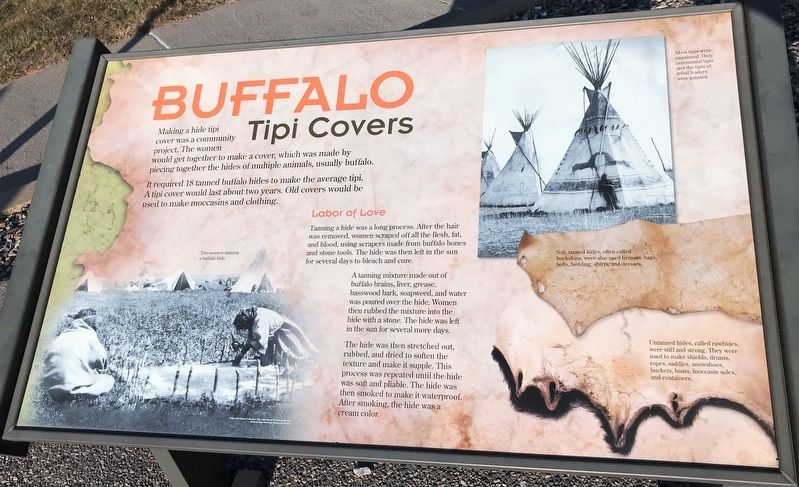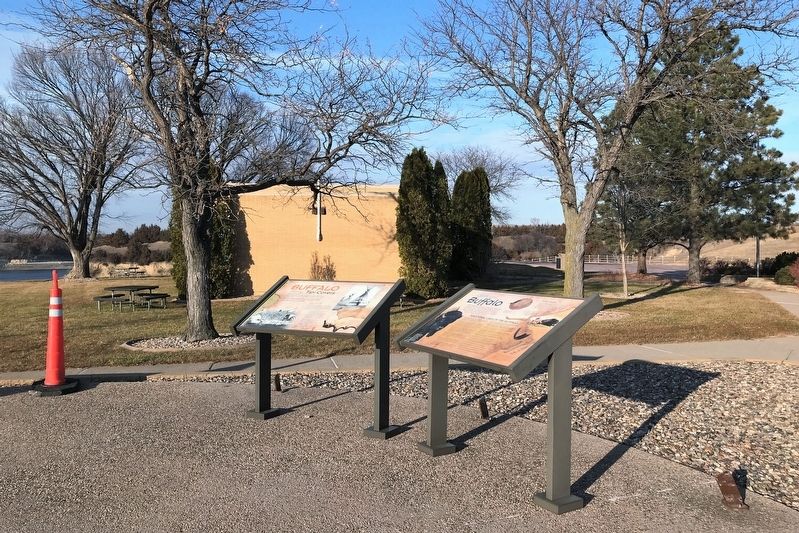Near Pickstown in Charles Mix County, South Dakota — The American Midwest (Upper Plains)
Buffalo Tipi Covers
Making a hide tipi cover was a community project. The women would get together to make a cover, which was made by piecing together the hides of multiple animals, usually buffalo.
It required 18 tanned buffalo hides to make the average tipi. A tipi cover would last about two years. Old covers would be used to make moccasins and clothing.
Labor of Love
Tanning a hide was a long process. After the hair was removed, women scraped off all the flesh, fat, and blood, using scrapers made from buffalo bones and stone tools. The hide was then left in the sun for several days to bleach and cure.
A tanning mixture made out of buffalo brains, liver, grease, basswood bark, soapweed, and water was poured over the hide. Women then rubbed the mixture into the hide with a stone. The hide was left in the sun for several more days.
The hide was then stretched out, rubbed, and dried to soften the texture and make it supple. This process was repeated until the hide was soft and pliable. The hide was then smoked to make it waterproof. After smoking, the hide was a cream color.
[Captions:]
Two women tanning a buffalo hide.
Most tipis were unpainted. Only ceremonial tipis and the tipis of tribal leaders were painted.
Soft, tanned hides, often called buckskins, were also used to make bags, belts, bedding, shirts, and dresses.
Untanned hides, called rawhides, were stiff and strong. They were used to make shields, drums, ropes, saddles, snowshoes, buckets, boats, moccasin soles, and containers.
Topics. This historical marker is listed in these topic lists: Animals • Anthropology & Archaeology • Native Americans.
Location. 43° 4.163′ N, 98° 32.736′ W. Marker is near Pickstown, South Dakota, in Charles Mix County. Marker is on U.S. 18, half a mile west of Missouri Drive, on the right when traveling west. The marker stands at the Fort Randall Dam Visitor Center. Touch for map. Marker is in this post office area: Lake Andes SD 57356, United States of America. Touch for directions.
Other nearby markers. At least 8 other markers are within walking distance of this marker. Gifts of the Buffalo (here, next to this marker); Women's Work: Making & Raising Tipis (here, next to this marker); Star Power (here, next to this marker); Tipi: "They Dwell" (here, next to this marker); Circle of Life (here, next to this marker); Fort Randall Dam - Lake Francis Case (a few steps from this marker); Pickstown / Lewis and Clark (approx. 0.7 miles away); Pickstown Centennial Garden Memorial (approx. 0.7 miles away). Touch for a list and map of all markers in Pickstown.
Credits. This page was last revised on December 6, 2021. It was originally submitted on December 6, 2021. This page has been viewed 126 times since then and 18 times this year. Photos: 1, 2. submitted on December 6, 2021. • Devry Becker Jones was the editor who published this page.

